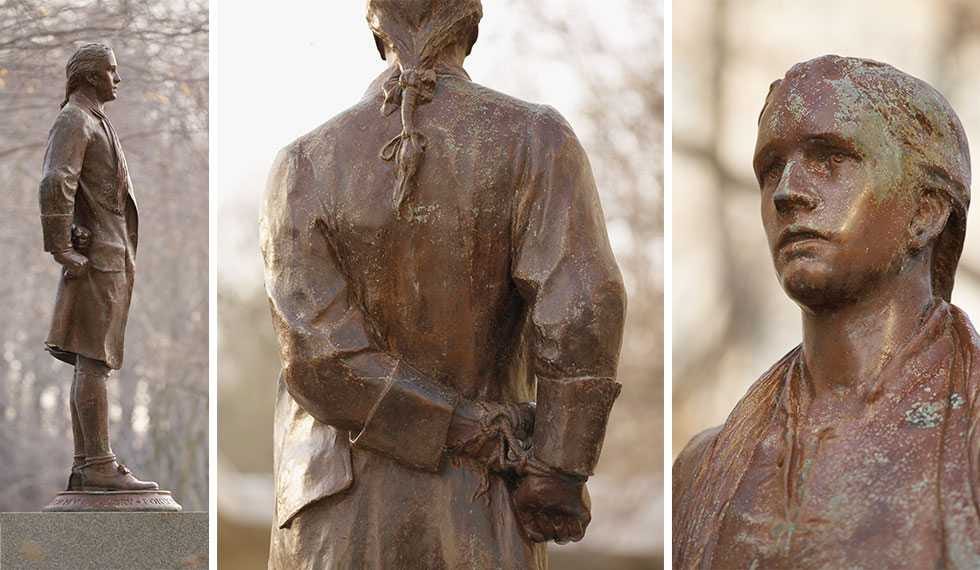As President Franklin D. Roosevelt’s secretary of war, Henry Stimson, once said, “Gentlemen don’t read each other’s mail.”
As it became more obvious that the United States would be entering the war against Germany, Japan, and Italy at some point in the near future, FDR apparently decided that was an idiotic notion, and shortly after the Pearl Harbor debacle, called on an old college chum, William “Wild Bill” Donovan, to help him create an effective intelligence arm for the US war effort. Donovan, a Medal of Honor winner and one of the most decorated military heroes in American history, became FDR’s “coordinator of intelligence, and from there he founded OSS and became its chief.” Today, he is regarded as the founding father of the CIA, and a statue of him stands in the lobby of the CIA headquarters building in Langley, Virginia.
Under Donovan the OSS became renowned for the unorthodox (at least by governmental bureaucratic standards) nature of its administration and its methods, which should probably have been expected from a guy given to charging, with a bullet-shattered knee, into the business ends of Nazi machine gun nests.
Nowhere were Donovan’s flaws more evident than in his hiring practices. Needing to throw together an agency quickly, he turned to his circle of friends in New York and hired blue bloods by the dozen. The OSS roster was lousy with Mellons, Du Ponts, Morgans, and Vanderbilts. Columnists joked that the agency’s initials actually stood for “Oh So Social.” In Donovan’s defense, hiring aristocrats did make sense on some level: They usually spoke several languages and knew Europe well.
One should keep in mind that the DNA of any organization is primarily established in its process of birth, and today’s CIA is no different. For instance, it is still true today that a high social pedigree coupled with attendance at an Ivy League college may well result in you being at least scouted for a position in America’s premier intelligence agency.
Perhaps the most prestigious institution Golden examines is Harvard University, probing its cozy relationship with the CIA. (While Harvard has recently come under scrutiny for its relationship with the agency after it withdrew an invitation for Chelsea Manning to be a visiting fellow -- after the agency objected to her appointment -- this book was written before the Manning incident, which occurred in September.)
The university, which has had varying degrees of closeness and coldness with the CIA over the years, currently allows the agency to send officers to the midcareer program at the Kennedy School of Government while continuing to act undercover, with the school’s knowledge. When the officers apply -- often with fudged credentials that are part of their CIA cover -- the university doesn’t know they’re CIA agents, but once they’re in, Golden writes, Harvard allows them to tell the university that they’re undercover.
I highly doubt that this is an accurate depiction of what really goes on. The Kennedy school’s acceptance rate is 33%, and I don’t see an agency like CIA rolling the dice to place recruiting officers within it based on a 2-1 likelihood of failure. As for Harvard “allowing” these agents to reveal themselves to the university, the converse is also likely true: if these officers choose not to, or are not permitted to by CIA, to reveal themselves, they don’t.
Their fellow students, however -- often high-profile or soon-to-be-high-profile actors in the world of international diplomacy -- are kept in the dark.
“Kenneth Moskow is one of a long line of CIA officers who have enrolled undercover at the Kennedy School, generally with Harvard’s knowledge and approval, gaining access to up-and-comers worldwide,” Golden writes. “For four decades the CIA and Harvard have concealed this practice, which raises larger questions about academic boundaries, the integrity of class discussions and student interactions, and whether an American university has a responsibility to accommodate U.S. intelligence.”
This method does not address the traditional Ivy League recruiting path, in which professors who are either current or former CIA officers recommended promising students for recruitment purposes. For instance:
Much of the history of the Bones-OSS/ CIA connection is covered by John F. McManus in his book William F. Buckley, Jr.: Pied Piper for the Establishment. Buckley, who was tapped for Skull and Bones while at Yale, was recruited into the CIA by his mentor, Yale Professor Willmoore Kendall, who had served in the OSS.
Not much has changed today. The CIA still maintains a significant recruiting presence on Ivy League campuses, especially Yale’s, where a particularly poignant connection stands in plain view at both places:
At the Central Intelligence Agency headquarters in Langley, Virginia, there is a statue of Yale graduate and father of American espionage Nathan Hale. It is a copy of the Hale statue that stands in front of the Connecticut Hall dormitory on Yale’s Old Campus. The sculpture isn’t the only thing the agency has copied from Yale.
The Agency, steeped in tradition, holds to the legend that placing a quarter—which bears the face of Washington whom Hale served under—around Hale’s statue will ensure the safety of officers preparing to leave for an assignment.
So there you have one strand of CIA’s DNA. It was created by Ivy Leaguers, in particular Ivy Leaguers who attended Yale, Harvard, and Princeton, and, in the sense that the OSS marked the true beginnings of CIA, which CIA itself seems to acknowledge, it was created in large part by Yale men who belonged to the Skull & Bones Society - although Donovan, the Godfather, was a Columbia man, and had no actual society background at all.
Next up in the series: The CIA: Still Crazy After All These Years
[As always, if you like my work, please consider supporting it with a paid subscription.
]







